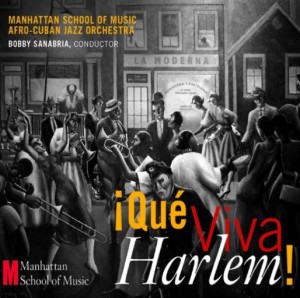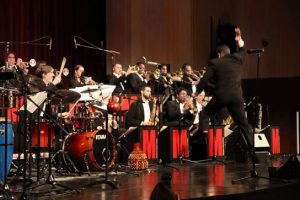The Latin Jazz maestro Bobby Sanabria again teamed-up with his Manhattan School of Music Afro Cuban Jazz Orchestra (MSM-ACJO) to release a terrific Jazz / Latin Jazz album titled “Que Viva Harlem”.
This is the 3rd collaboration of the 7-time Grammy nominated Latin Jazz maestro, and his students’ big band. The previous 2 albums, “Kenya Revisited Live” and “Tito Puente Masterworks Live” both earned him Grammy nominations.
As the previous albums, “Que Viva Harlem” was recorded “live”. The reason, as the maestro Bobby Sanabria explained to me in an interview for Latino Music Café, is that it is much more feasible, financially and logistically, to do a “live” recording with the MSM-ACJO in their auditorium facility.
Music from Spanish and Black Harlem
As you can probably guess by the title, “Que Viva Harlem” focuses on the music that was played in that area of New York, not just in Spanish Harlem (El Barrio), but also in Black Harlem. This explains why some of the 8 songs of the album are plain Jazz songs, rather than Latin Jazz.

Or so it seemed to me. But in my conversation with Bobby Sanabria, he helped me get my facts right. For example, the tune “Oclupaca” was part of Duke Ellington’s Latin American suite, and the maestro Sanabria’s arrangement highlighted the “Afro-Son” rhythmical root of the song.
I also learned from maestro Sanabira that “Moon Over Cuba”, composed by Puerto Rican trombonist Juan Tizol (of Duke’s orchestra), was originally titled “Lady of Puerto Rico” and was renamed due to the great fad everything Cuba had in those days.
But also, I thought this song was straight jazz, when it reality Bobby described it as a “Bolero-rumba”, a faster-paced form of the classic “bolero”, which could be heard in New York’s Waldorf Astoria played by Xavier Cougart’s orchestra. I wasn’t too far off in thinking this music reminded me of Humphrey Bogart in “Casablanca” and the music of that movie, with its sound of ballroom elegance.
I mentioned to the maestro an interesting fact I noticed regarding the scope of his 3 albums with the MSM-ACJO. The 1st album was a tribute to one recording; the 2nd album was a tribute to an artist’s life work, and now the 3rd expands to a tribute of a whole neighborhood. When I asked Bobby Sanabria how the concept for “Que Viva Harlem” was born, he quickly said it wasn’t his idea.
In this audio clip of my interview with the maestro Sanabria, he explains the genesis of the concept for “Que Viva Harlem”.
What I Liked About “Que Viva Harlem”
Well Chosen Song & Great Arrangements – there are only 8 songs in this album, but don’t be fooled, there is plenty of music. Two of the songs are 12 and 18 minutes in duration. The song reflect the diverse music that represented a musical era in Harlem.

The musical arrangements are aggressive, which highlights sound and mastery of the collective big band ensemble, and also provide the band members plenty of opportunity to showcase their individual talents. And in Bobby’s band, anyone can be a soloist, not just the top instrument players.
It seems to me the that the arrangements keep getting more complex with every album of the MSM-ACJO. The two long scores I mentioned before, are part of a standard Bobby Sanabria adds to all his recordings.
As the maestro Sanabria explained, these long scores, which add an extra complexity to the arrangements and execution of the music, is something started by Chico O’Farrill with Machito Afro Cubans.
In this audio-clip Bobby Sanabria explains the increased complexity of the music in “Que Viva Harlem”.
Excellent Band Performance – The MSM-ACJO plays flawlessly during the album. My music aficionado ears could not detect any execution flaws by the band. Bobby Sanabria mentioned that recording live brings out the best of the musicians, as “there is a heightened sense of awareness”.
Other Opportunities for “Que Viva Harlem”
Add Guest Artists – In the previous 2 albums Bobby Sanabria has guest artists to play with the MSM-ACJO. Although this is a big band of students, they play as pro’s and really don’t need musical help from anyone.
That said, I believe guest artists bring a good marketing aspect and musical flair to the album. I think the public would enjoy having a recognizable name (besides Bobby Sanabria himselft) in the album, and the music provides plenty of space for it.
“Que Viva Harlem” an Enjoyable Listening Experience
I loved “Que Viva Harlem” from start to finish. An album that has musical variety and aggressiveness, but yet polished and impeccably executed.
Jazz and Latin music lovers will equally enjoy this album, as its full of great music, with Harlem musical history attached to it.
I believe that “Que Viva Harlem” will surely earn Bobby Sanabria an 8th Grammy nomination, and hopefully his 1st golden phonograph trophy.


[…] this video review of Bobby Sanabria’s “Tito Puente Masterworks Live”, I touch on some of the facts about this recording. I […]